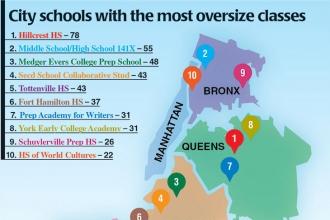
UFT President Michael Mulgrew
We’ve seen a dramatic drop in the number of oversize classes early in the school year. As of Oct. 18, only 83 schools without a history of chronic class-size problems had classes reported as oversize — thanks to class-size reduction provisions negotiated as part of the 2018 Department of Education-UFT contract that were designed to get faster relief for teachers and students. It’s one of the most important changes we negotiated and something we as union members can be proud of.
One of the things we all know as teachers is that class size makes a huge difference in managing a classroom effectively. Limiting class size is crucial to differentiating instruction and reaching students at all learning levels. Crowded classrooms deprive teachers of the ability to provide that one-on-one attention all students benefit from.
That’s why we were one of the first teacher unions in the country to negotiate class-size limits. And that’s why when the Chicago Teachers Association went on strike in October, among its demands was the inclusion of class-size caps and how to enforce them in its contract. (#PutItInWriting is its strike hashtag.) As Chicago teachers were trying to get the right to smaller class sizes in their contract, we have been engaged in making sure the class-size limits already inscribed in our contract are actually enforced.
The new class-size process was long overdue and necessary. The only rules that limit class size in New York City schools are those established in the UFT contract, but the previous contractual process for resolving overages was not working for us. The class-size limits were only enforceable through a process of hearings before independent third-party arbitrators. But because of the annual backlog of cases awaiting arbitration, that process often took months and schools faced no consequences for keeping class sizes over limits up to the day of the hearing. Even the DOE action plans imposed as a result of arbitration had no built-in urgency.
The old way meant schools would sometimes not lower class sizes to contractual limits until April or May. Something had to be done.
What we negotiated in the 2018 contract was a series of new steps and deadlines to resolve the overages in every district, so only the most intractable cases go to arbitration. Principals still have 10 school days to work with chapter leaders to resolve oversize classes in their school buildings. But instead of going directly to arbitration after that, any unresolved cases now get handed to district representatives and superintendents to tackle. On the 21st day, unresolved cases get escalated a step higher to a central committee with equal union and DOE representation.
At day 10 of the school year this year, there were 350 schools with a total of 1,570 oversize classes, down from more than 400 schools and more than 2,000 oversize classes at that same time last year. The number of oversize classes continued to drop as cases made their way through the new resolution process.
When space or other issues prevent schools from lowering the number of students in a classroom, schools are coming into compliance by taking other steps, including providing either a second teacher or a paraprofessional for the class or providing the teacher with more preparation time.
Our new class-size procedure is having a ripple effect, too. Of the 200 arbitration slots available to the UFT each year, roughly half went to class size in years past. This year, only 12 arbitration slots will be for class size, freeing up the rest for other types of grievances, including salary grievances.
Thanks to our new rules, far fewer kids are finding themselves in overcrowded classrooms, and those in oversize classes are getting relief sooner.
New provisions speed class-size reductions
Teachers across the city got relief from oversize classes this fall at a faster pace than ever before — thanks to new class-size reduction provisions negotiated as part of the 2018 Department of Education-UFT contract and implemented citywide in September.
